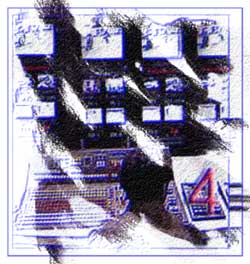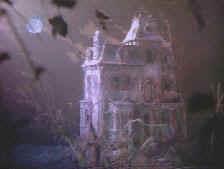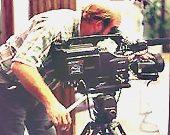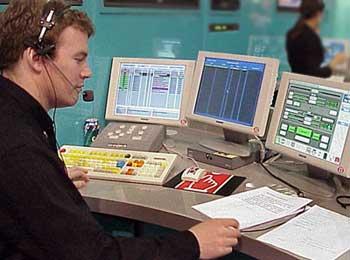|
|
Updated: 06/26/2005 |
|
|
|
|
|||
|
The Production
To start with we might as well think big. The following 15 steps cover the production steps involved in
an elaborate television production. Once you get a feel for the whole process, you
can then scale down things for whatever size production you have in mind. Identify the Purpose of the Production 1. The most important step is the first one: clearly identify the goals and purposes of the production. If there is no clear agreement on the goal or purpose of a production, it will be impossible to evaluate success. (How do you know if you've arrived at your destination, if you didn't know where you were going in the first place?) Is the purpose to instruct, inform, entertain, or possibly to generate feelings of pride, or social, religious or political need? Possibly the real purpose of the production is to create a desire in the audience to take some action. And, let's be honest, the primary goal of most broadcasting
is simply to hold the interest of an audience so they will be influenced by the
commercials. Even Most productions have more than one goal. We'll elaborate on some of these later.
|
|
Analyze Your Target Audience 2. Next, identify
and analyze your target audience. Based on such things as age, sex, socioeconomic status, educational level, etc., program content preferences will differ. These preferences are also different for different parts of the United States (North, South, urban, rural, etc.). Audience characteristics are referred to as demographics. These regional demographic variations can in part be seen by
differences in the local programming broadcast in different parts of the country-and
sometimes by the films and network programming that some local stations decide not
to air. Chief among the content issues are sex and violence--both of which have
been shown to have a positive relationship to ratings. Demographics Determine the Generally speaking-and, of course, there are many exceptions-when it comes to sexual themes people who live in Northern urban areas of the United States tend to be more tolerant than people who have a rural background and live in the South. Education is also related. Research shows that, generally speaking, the more education an audience has, the less opposition there will be to sexual themes. Interestingly, it appears that this relationship seems to reverse when it comes to violence. Why are things like this important to know? Here's an example. Knowing that more than 40,000 women die each year of breast cancer in the United States, and that most of these deaths could be prevented by early detection, a female program manager of a TV station in the South decided to run a PSA (public service announcement) on doing a breast self-examination. Even though the PSA ran late at night and seemed rather bland in its approach, there was immediate negative reaction from members of the audience who thought that the subject matter was too personal to be broadcast. Consequently, because of viewer complaints the PSA had to be canceled. At the same time some, PBS (Public Broadcasting) stations have run programming with full frontal nudity late at night without appreciable reaction. The difference? Demographics. The people who were most apt to complain weren't watching, and the people who were watching were least apt to complain. You may have a compulsion to "just tell it like it is" and not be concerned if you alienate your audience. Time to review those Reality 101 notes. If you consistently disregard audience preferences and predispositions, you will have a limited future in TV production. But, what if you are not producing programming for broadcast or general distribution? Compared to standard broadcast television, institutional television, which includes corporate and educational video, has different needs and expectations. But, here, too, demographic characteristics, such as age, sex, and education influence a production's form and content. In institutional television the producer and scriptwriter also have to be fully aware of the audience's experience, education, needs, and expectations. For example, to underestimate education or experience
and inadvertently "talk down to" an audience insults them. To overestimate
education or experience and talk over everyone's head is just as bad. Either way
you lose. Check Out Similar Productions 3 . Check out similar productions done in the past. If you are going to make mistakes, at least make new ones. Ask yourself some questions. How will your proposed production
differ from the successful and unsuccessful efforts that have been done in the past?
Why did they work; or, maybe more importantly, why didn't they work? Of course,
since production styles change rapidly, you need to take into consideration differences
in time, locations, and audiences. Determine the Basic 4. Next, determine
the overall value of the production to a sponsor or underwriter. Obviously,
underwriters and advertisers want some sort of return on their investment. (Reality
101 rears its head again!) Although we will cover costing out a production later, here we want to make sure we can justify production expense in terms of some sort of gain or return on the investment. For this you'll need to ask yourself some more questions. First, what is the probable size of the audience? In determining this you must know whether your show will be a one-shot presentation or whether production expenses can be recouped over time by presenting the show to other audiences. Generally, the larger the audience the more marketable a production will be to an underwriter or advertiser. At the same time, simple numbers don't tell the whole story. Let's say an advertiser has a product designed for young people-athletic shoes or designer jeans, for example. In this case a production that draws a large percentage of this age group will be more valuable than a production that has a larger overall audience, but a lower percentage of young people. More than one TV series has been cancelled, not because it had a small audience, but because it had the "wrong kind" of audience. Consider Return on Investment The potential value of a production to an advertiser or underwriter has to be balanced with the projected cost of producing and presenting the production. If the costs exceed the benefits, you've got problems! In commercial television the "return on the investment" is generally
in the form of increased sales and profits. But, it may take other forms, such as
the expected moral, political, spiritual, or public relations benefit derived from
the program. Develop a Treatment 5. Next, put it down on paper. There are several steps to this and they span the interval from the initial proposal to the final shooting script. You'll recall that earlier we talked about treatments and program proposals (written summaries of what you propose to do). After the program proposal or treatment is approved, a full script is requested. (Remember, we're talking about a major production here.) It will be at this point that any remaining research on the
content will be commissioned. For example, if the script calls for someone watching
TV in a 1960s period piece (a production that takes place
during a specific historic era) we'd need to check on what television shows were
being broadcast at that time. (Would we see an episode of Law&Order on
a TV screen during a documentary on Elvis Presley?) The first version of the script is generally followed by numerous revisions. Throughout the rewriting process a number of story conferences or script conferences typically take place. During these sessions such things as audience appeal, pace, problems with special interest groups, etc., are thrashed out and alternative ideas are considered. If it's an institutional production, the goals of the production will be reviewed and questions about the most effective way of presenting the ideas will be decided. If the director is on board (step #7) at this time, he or she should be a part of these conferences. Finally, a script version emerges that is (we can hope) more or less acceptable to everyone. However, even this version will probably not be final. In many instances scene revisions continue right up to the time the scenes are shot. Typically, in a dramatic film production each new script version
is issued on a different color paper so that the cast and crew won't confuse them
with earlier versions. ("Margaret, wake up; you're going by the pink Depending on the production, a storyboard may be developed. A storyboard consists of drawings of key scenes with corresponding notes on dialogue, sound effects, music, etc. (Note the illustration on the right.) Today, high-budget film and video productions create sophisticated
storyboards with software supplied by companies such as
6. Next, you should draw up a tentative schedule. Generally, broadcast or distribution deadlines will dictate the production schedule (the written timetable listing the time allotted for each production step). Not planning things out carefully might cause you to miss a
critical deadline, which could render the production useless. Select Key Production Personnel 7. At about this
point remaining above-the-line production personnel are brought on board.
In addition to the producer and writer, the above-the-line personnel
include the production manager and director and, in general, the key creative team
members. The below-the-line personnel, who are generally
assigned later, include the technical staff. Decide On Locations 8. Next, if the
production isn't done in the studio, you need to decide on key locations.
In a major production a location scout or location
manager will be hired to find and coordinate the use of the locations suggested
by the script. Although it might be easier to shoot in a TV studio, it
has been shown that audiences like the authenticity of "real" locations, especially
in dramatic productions. Cities that encourage TV and film production have film commissions that supply photos and videotapes of interesting shooting locations in their area. These commissions are located in most major cities, and they will provide information on usage fees and the people who need to be contacted. It's often necessary to make some changes in the on-location
settings. Rooms may have to be repainted or redecorated, signs changed, etc. Decide On Talent, Wardrobe and Sets 9. Next you will want to make some decisions on talent, wardrobe (costuming) and sets. Depending upon the type of production, auditions may take place at this point as part of the casting process (selecting the people for the various roles). Once decisions are made, contracts can be negotiated and signed. If you are lucky enough to be able to afford well-known actors, they will probably have been decided on early in the preproduction process. After a set designer is hired, he or she will review the script, possibly do some research, and then discuss initial ideas with the director. Once there's agreement, sketches of the sets can be made for final approval before actual set construction starts-if there is any construction. As we will see, today, many sets exist only in computers. In this case the sketches will be turned over to a computer artist. Once the talent or actors are decided on, the selection of wardrobes can start. These are suggested by the script and coordinated with the the look of the sets and locations, and ultimately approved by director. Rehearsals, from initial table readings to the final dress rehearsal,
can then be scheduled. Even though sets may not be finished at this point, the talent
can start reading through the script with the director to establish pace, emphasis,
and basic blocking (positioning of sets, furniture, cameras,
actors, etc.). Once the sets are finished, final blocking and dress rehearsals can
get underway. Decide on the Remaining 10. Make decisions on remaining staff and production needs. At this point arrangements can be made for key technical personnel, equipment, and facilities. This includes the rental of both equipment and production facilities. Transportation, catering (food and refreshment trucks), and on-location accommodations (for overnight stays) must also be arranged. If unions are involved, their contracts will cover job descriptions
and specific crew responsibilities. Working hours, including graduated pay increases
for overtime hours, will also be spelled out. In addition, unions often set minimum
standards for transportation, and the quality of meals and accommodations. Obtain Permits, Insurance and Clearances 11. In major cities and in many foreign countries it's not possible to just go to the location of your choice, set up your tripod, and start filming. Except for spot news and short documentary segments, access permits, licenses, security bonds and insurance policies must be arranged. Many semipublic interior locations, such as shopping malls, require filming permits.(Yes, things do get complicated!) Depending on the nature of the production, liability insurance and security bonds may be necessary in case an accident is directly or indirectly attributed to the production. In some locations the controlling agency will limit exterior production to certain areas and to specific hours. If there's a street scene and traffic will be affected, it will be necessary to arrange for special police. Included in this category are a wide variety of clearances, which range from permission to use prerecorded music to reserving satellite time to transmit the production back to a studio. If clearance cannot be obtained, alternatives must be quickly explored. Are you beginning to see why the list of
credits at the end of films and TV programs is so long? Select Video Inserts, 12. At this point arrangements can be made for shooting or acquiring any videotape or film inserts, still photos and graphics that might be needed. To reduce production costs, existing stock footage may be located in film or tape libraries around the country. This generally consists of background footage, such as general exterior scenes of an area that will edited into the production. Just one example of a stock footage source is If suitable footage If part of a dramatic production calls for a specific building in Cleveland, for example, a second unit can shoot the necessary exteriors in Cleveland while the interior shots (which are supposedly taking place inside the building) are shot in Southern California where the actors live. Initial decisions on music are also made at this point. Copyright
clearances and royalties must be worked out for music and visual inserts. These
things will be discussed in more detail later. Moving to Rehearsals and Shooting 13. Depending on the type of production, rehearsal may take place either minutes or days before the actual shooting. Productions shot live-on-tape (without stopping except for major problems) must be completely rehearsed before recording starts. This includes early walk-through rehearsals, camera rehearsals, and one or more dress rehearsals. Productions shot single-camera, film-style (to be covered later)
are recorded one scene at a time. In this case, rehearsals can take place right
before each scene is shot. The Editing Phase 14. After
shooting is completed, the producer, director, and video recording editor review
the footage and editing decisions are made. For major productions this has traditionally
been done in two phases. Using this edited tape and an EDL (edit decision list) as a guide, the production then moves to on-line editing where much more sophisticated (and expensive) equipment was used to create the edited master, the final edited version of the tape. During this final editing phase all necessary sound sweetening (enhancing), color balancing, and special effects are added. As high-quality nonlinear, digital editing becomes widely Because editing is so important to the creative process, we are going to devote several chapters to the subject. If all these terms and procedures sound a bit intimidating right now, don't worry; we'll explain them in more detail later.
15. Although most of the production crew will be finished with their work once the production wraps (finishes), there is still much in the way of follow-up work to be done. Final bills have to be paid, financial statements totaled, and the success (or failure) of the production determined. Broadcast television has ratings; in institutional television there may be tests, evaluations, or simply informal viewer feedback to consider. And speaking of ratings-those numbers that
spell the success or the death of TV programs-make sure you In the next module we'll turn our attention to that important "blueprint" for the entire TV production, the script. |




 pages, and now we're on the yellow!!")
pages, and now we're on the yellow!!")

 (Note: For the convenience of readers links such as this are included in this
cybertext. However, this should in no way be considered an endorsement, and no compensation
is received by CyberCollege or the InternetCampus for listing these links.)
(Note: For the convenience of readers links such as this are included in this
cybertext. However, this should in no way be considered an endorsement, and no compensation
is received by CyberCollege or the InternetCampus for listing these links.) used, the need for an off-line editing phase may be eliminated, or at least made
optional. (Just one more of those things we'll talk about later!)
used, the need for an off-line editing phase may be eliminated, or at least made
optional. (Just one more of those things we'll talk about later!)